2007 CHEVROLET EQUINOX traction control
[x] Cancel search: traction controlPage 145 of 492
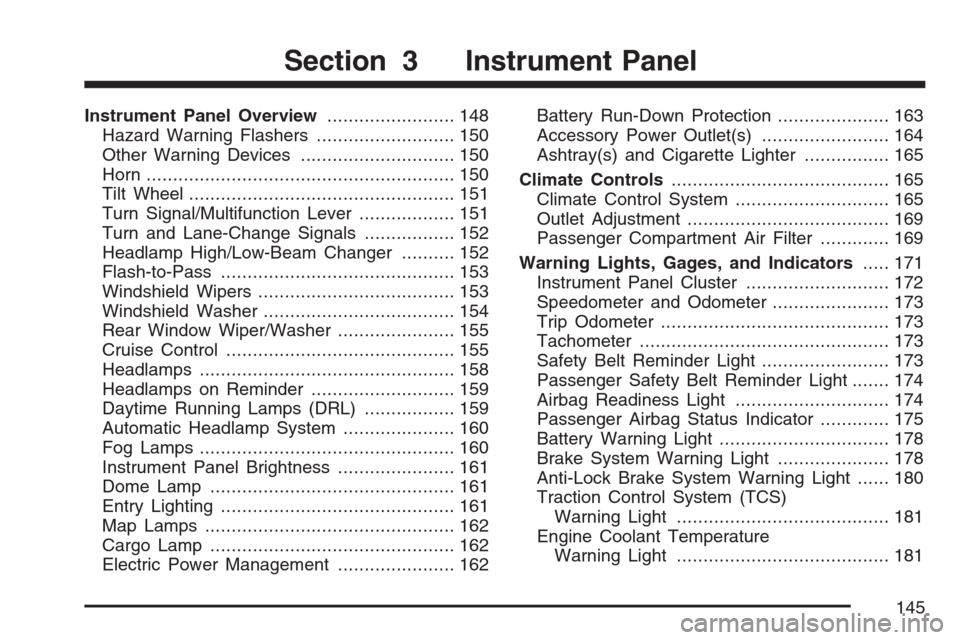
Instrument Panel Overview........................ 148
Hazard Warning Flashers.......................... 150
Other Warning Devices............................. 150
Horn.......................................................... 150
Tilt Wheel.................................................. 151
Turn Signal/Multifunction Lever.................. 151
Turn and Lane-Change Signals................. 152
Headlamp High/Low-Beam Changer.......... 152
Flash-to-Pass............................................ 153
Windshield Wipers..................................... 153
Windshield Washer.................................... 154
Rear Window Wiper/Washer...................... 155
Cruise Control........................................... 155
Headlamps................................................ 158
Headlamps on Reminder........................... 159
Daytime Running Lamps (DRL)................. 159
Automatic Headlamp System..................... 160
Fog Lamps................................................ 160
Instrument Panel Brightness...................... 161
Dome Lamp.............................................. 161
Entry Lighting............................................ 161
Map Lamps............................................... 162
Cargo Lamp.............................................. 162
Electric Power Management...................... 162Battery Run-Down Protection..................... 163
Accessory Power Outlet(s)........................ 164
Ashtray(s) and Cigarette Lighter................ 165
Climate Controls......................................... 165
Climate Control System............................. 165
Outlet Adjustment...................................... 169
Passenger Compartment Air Filter............. 169
Warning Lights, Gages, and Indicators..... 171
Instrument Panel Cluster........................... 172
Speedometer and Odometer...................... 173
Trip Odometer........................................... 173
Tachometer............................................... 173
Safety Belt Reminder Light........................ 173
Passenger Safety Belt Reminder Light....... 174
Airbag Readiness Light............................. 174
Passenger Airbag Status Indicator............. 175
Battery Warning Light................................ 178
Brake System Warning Light..................... 178
Anti-Lock Brake System Warning Light...... 180
Traction Control System (TCS)
Warning Light........................................ 181
Engine Coolant Temperature
Warning Light........................................ 181
Section 3 Instrument Panel
145
Page 149 of 492
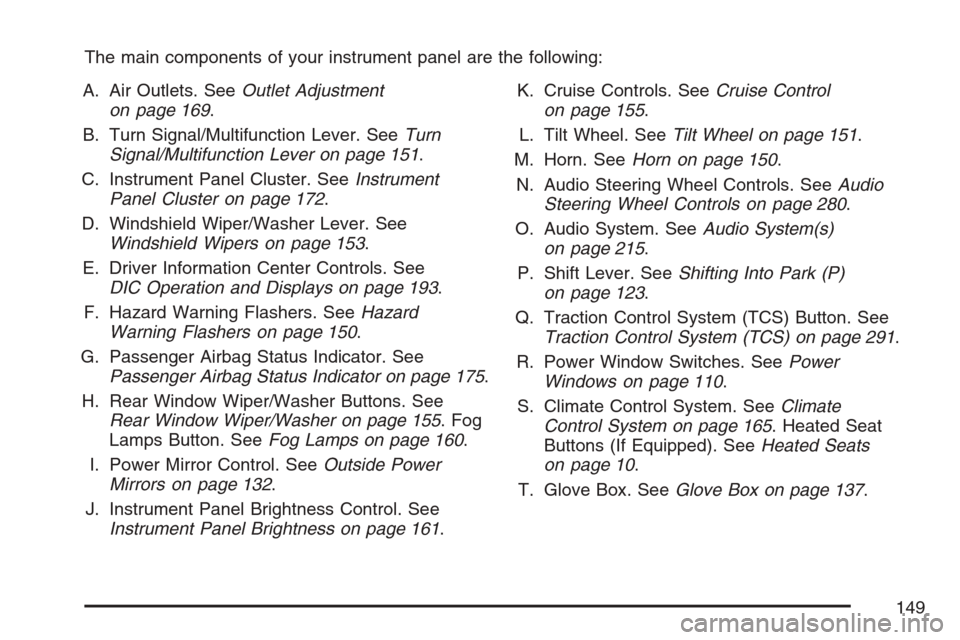
The main components of your instrument panel are the following:
A. Air Outlets. SeeOutlet Adjustment
on page 169.
B. Turn Signal/Multifunction Lever. SeeTurn
Signal/Multifunction Lever on page 151.
C. Instrument Panel Cluster. SeeInstrument
Panel Cluster on page 172.
D. Windshield Wiper/Washer Lever. See
Windshield Wipers on page 153.
E. Driver Information Center Controls. See
DIC Operation and Displays on page 193.
F. Hazard Warning Flashers. SeeHazard
Warning Flashers on page 150.
G. Passenger Airbag Status Indicator. See
Passenger Airbag Status Indicator on page 175.
H. Rear Window Wiper/Washer Buttons. See
Rear Window Wiper/Washer on page 155. Fog
Lamps Button. SeeFog Lamps on page 160.
I. Power Mirror Control. SeeOutside Power
Mirrors on page 132.
J. Instrument Panel Brightness Control. See
Instrument Panel Brightness on page 161.K. Cruise Controls. SeeCruise Control
on page 155.
L. Tilt Wheel. SeeTilt Wheel on page 151.
M. Horn. SeeHorn on page 150.
N. Audio Steering Wheel Controls. SeeAudio
Steering Wheel Controls on page 280.
O. Audio System. SeeAudio System(s)
on page 215.
P. Shift Lever. SeeShifting Into Park (P)
on page 123.
Q. Traction Control System (TCS) Button. See
Traction Control System (TCS) on page 291.
R. Power Window Switches. SeePower
Windows on page 110.
S. Climate Control System. SeeClimate
Control System on page 165. Heated Seat
Buttons (If Equipped). SeeHeated Seats
on page 10.
T. Glove Box. SeeGlove Box on page 137.
149
Page 155 of 492
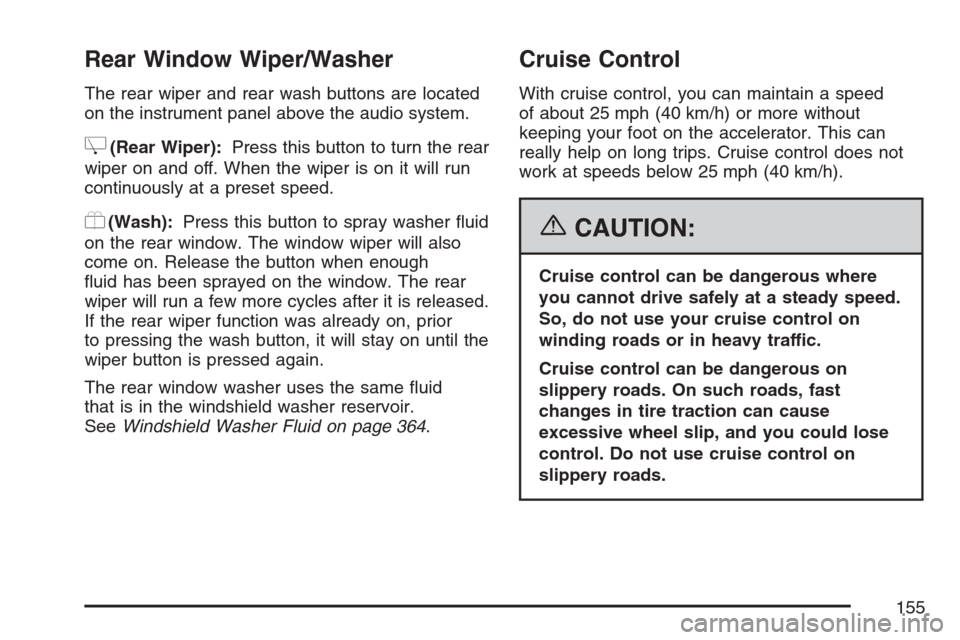
Rear Window Wiper/Washer
The rear wiper and rear wash buttons are located
on the instrument panel above the audio system.
Z(Rear Wiper):Press this button to turn the rear
wiper on and off. When the wiper is on it will run
continuously at a preset speed.
Y(Wash):Press this button to spray washer �uid
on the rear window. The window wiper will also
come on. Release the button when enough
�uid has been sprayed on the window. The rear
wiper will run a few more cycles after it is released.
If the rear wiper function was already on, prior
to pressing the wash button, it will stay on until the
wiper button is pressed again.
The rear window washer uses the same �uid
that is in the windshield washer reservoir.
SeeWindshield Washer Fluid on page 364.
Cruise Control
With cruise control, you can maintain a speed
of about 25 mph (40 km/h) or more without
keeping your foot on the accelerator. This can
really help on long trips. Cruise control does not
work at speeds below 25 mph (40 km/h).
{CAUTION:
Cruise control can be dangerous where
you cannot drive safely at a steady speed.
So, do not use your cruise control on
winding roads or in heavy traffic.
Cruise control can be dangerous on
slippery roads. On such roads, fast
changes in tire traction can cause
excessive wheel slip, and you could lose
control. Do not use cruise control on
slippery roads.
155
Page 157 of 492
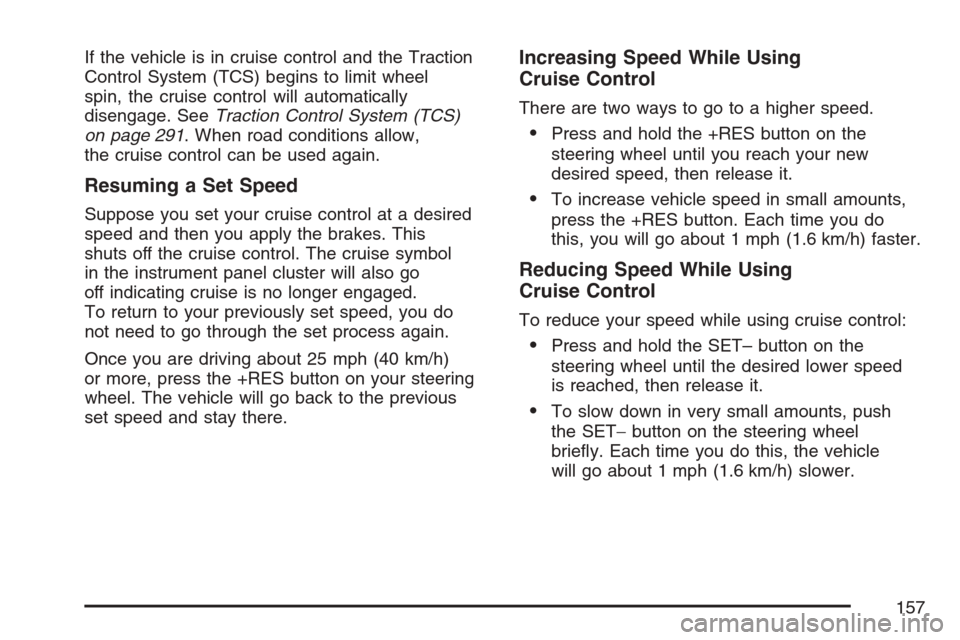
If the vehicle is in cruise control and the Traction
Control System (TCS) begins to limit wheel
spin, the cruise control will automatically
disengage. SeeTraction Control System (TCS)
on page 291. When road conditions allow,
the cruise control can be used again.
Resuming a Set Speed
Suppose you set your cruise control at a desired
speed and then you apply the brakes. This
shuts off the cruise control. The cruise symbol
in the instrument panel cluster will also go
off indicating cruise is no longer engaged.
To return to your previously set speed, you do
not need to go through the set process again.
Once you are driving about 25 mph (40 km/h)
or more, press the +RES button on your steering
wheel. The vehicle will go back to the previous
set speed and stay there.
Increasing Speed While Using
Cruise Control
There are two ways to go to a higher speed.
Press and hold the +RES button on the
steering wheel until you reach your new
desired speed, then release it.
To increase vehicle speed in small amounts,
press the +RES button. Each time you do
this, you will go about 1 mph (1.6 km/h) faster.
Reducing Speed While Using
Cruise Control
To reduce your speed while using cruise control:
Press and hold the SET– button on the
steering wheel until the desired lower speed
is reached, then release it.
To slow down in very small amounts, push
the SET−button on the steering wheel
brie�y. Each time you do this, the vehicle
will go about 1 mph (1.6 km/h) slower.
157
Page 181 of 492
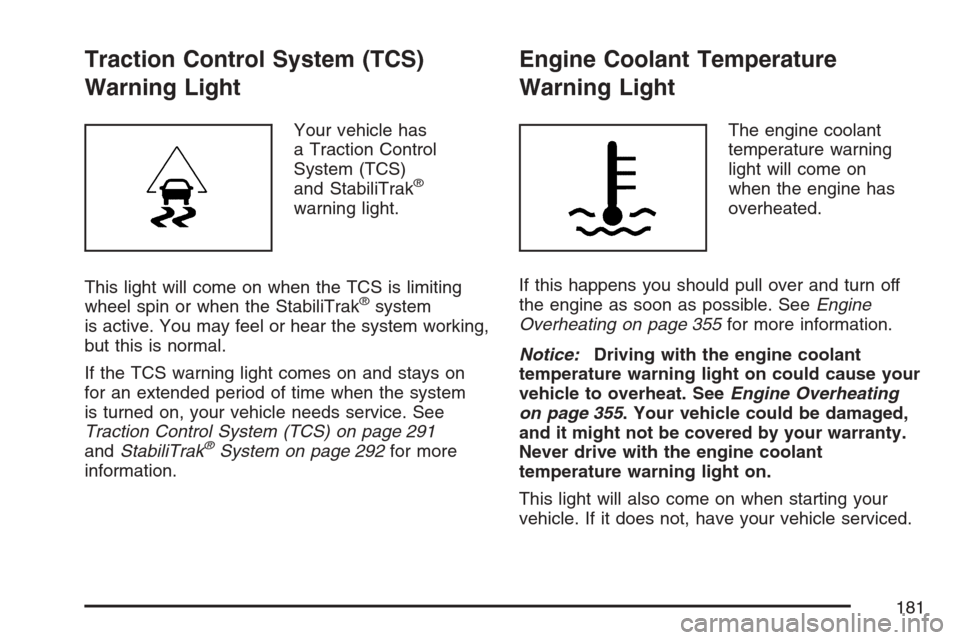
Traction Control System (TCS)
Warning Light
Your vehicle has
a Traction Control
System (TCS)
and StabiliTrak
®
warning light.
This light will come on when the TCS is limiting
wheel spin or when the StabiliTrak
®system
is active. You may feel or hear the system working,
but this is normal.
If the TCS warning light comes on and stays on
for an extended period of time when the system
is turned on, your vehicle needs service. See
Traction Control System (TCS) on page 291
andStabiliTrak
®System on page 292for more
information.
Engine Coolant Temperature
Warning Light
The engine coolant
temperature warning
light will come on
when the engine has
overheated.
If this happens you should pull over and turn off
the engine as soon as possible. SeeEngine
Overheating on page 355for more information.
Notice:Driving with the engine coolant
temperature warning light on could cause your
vehicle to overheat. SeeEngine Overheating
on page 355. Your vehicle could be damaged,
and it might not be covered by your warranty.
Never drive with the engine coolant
temperature warning light on.
This light will also come on when starting your
vehicle. If it does not, have your vehicle serviced.
181
Page 204 of 492
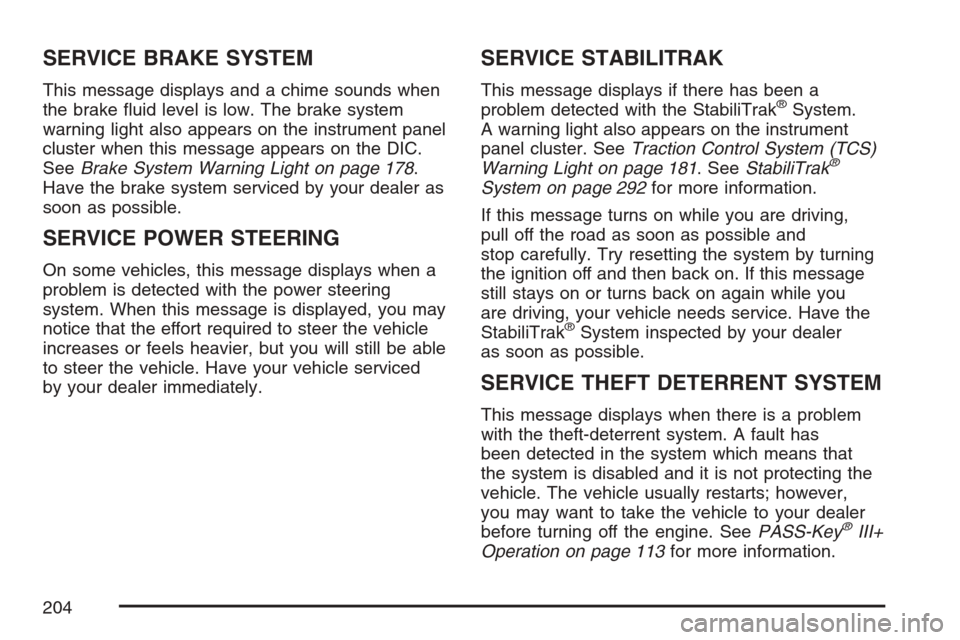
SERVICE BRAKE SYSTEM
This message displays and a chime sounds when
the brake �uid level is low. The brake system
warning light also appears on the instrument panel
cluster when this message appears on the DIC.
SeeBrake System Warning Light on page 178.
Have the brake system serviced by your dealer as
soon as possible.
SERVICE POWER STEERING
On some vehicles, this message displays when a
problem is detected with the power steering
system. When this message is displayed, you may
notice that the effort required to steer the vehicle
increases or feels heavier, but you will still be able
to steer the vehicle. Have your vehicle serviced
by your dealer immediately.
SERVICE STABILITRAK
This message displays if there has been a
problem detected with the StabiliTrak®System.
A warning light also appears on the instrument
panel cluster. SeeTraction Control System (TCS)
Warning Light on page 181. SeeStabiliTrak
®
System on page 292for more information.
If this message turns on while you are driving,
pull off the road as soon as possible and
stop carefully. Try resetting the system by turning
the ignition off and then back on. If this message
still stays on or turns back on again while you
are driving, your vehicle needs service. Have the
StabiliTrak
®System inspected by your dealer
as soon as possible.
SERVICE THEFT DETERRENT SYSTEM
This message displays when there is a problem
with the theft-deterrent system. A fault has
been detected in the system which means that
the system is disabled and it is not protecting the
vehicle. The vehicle usually restarts; however,
you may want to take the vehicle to your dealer
before turning off the engine. SeePASS-Key
®III+
Operation on page 113for more information.
204
Page 205 of 492
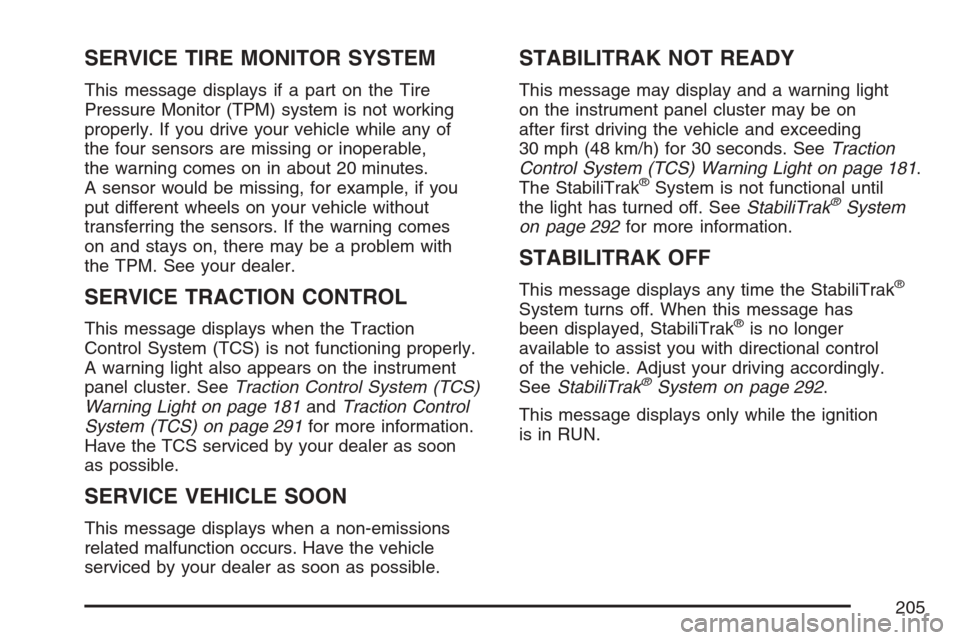
SERVICE TIRE MONITOR SYSTEM
This message displays if a part on the Tire
Pressure Monitor (TPM) system is not working
properly. If you drive your vehicle while any of
the four sensors are missing or inoperable,
the warning comes on in about 20 minutes.
A sensor would be missing, for example, if you
put different wheels on your vehicle without
transferring the sensors. If the warning comes
on and stays on, there may be a problem with
the TPM. See your dealer.
SERVICE TRACTION CONTROL
This message displays when the Traction
Control System (TCS) is not functioning properly.
A warning light also appears on the instrument
panel cluster. SeeTraction Control System (TCS)
Warning Light on page 181andTraction Control
System (TCS) on page 291for more information.
Have the TCS serviced by your dealer as soon
as possible.
SERVICE VEHICLE SOON
This message displays when a non-emissions
related malfunction occurs. Have the vehicle
serviced by your dealer as soon as possible.
STABILITRAK NOT READY
This message may display and a warning light
on the instrument panel cluster may be on
after �rst driving the vehicle and exceeding
30 mph (48 km/h) for 30 seconds. SeeTraction
Control System (TCS) Warning Light on page 181.
The StabiliTrak
®System is not functional until
the light has turned off. SeeStabiliTrak®System
on page 292for more information.
STABILITRAK OFF
This message displays any time the StabiliTrak®
System turns off. When this message has
been displayed, StabiliTrak®is no longer
available to assist you with directional control
of the vehicle. Adjust your driving accordingly.
SeeStabiliTrak
®System on page 292.
This message displays only while the ignition
is in RUN.
205
Page 206 of 492

Any of the following conditions may cause the
StabiliTrak®System to turn off:
The StabiliTrak®System is turned off by
pressing and holding the traction control
button. SeeStabiliTrak
®System on page 292
for more information.
The battery is low.
There is a StabiliTrak®System failure.
See your dealer for service.
STARTING DISABLD (Disabled)
SERVICE THRTTLE (Throttle)
This message displays if the starting of the engine
is disabled due to the electronic throttle control
system. Have your vehicle serviced by your dealer
immediately.
This message only appears while the ignition is
in RUN, and will not disappear until the problem
is resolved.
This message cannot be acknowledged.
THEFT ATTEMPTED
This message displays if the content theft-deterrent
system has detected a break-in attempt while
you were away from your vehicle. SeeContent
Theft-Deterrent on page 111for more information.
TIRE LEARNING ACTIVE
This message displays when the Tire Pressure
Monitor (TPM) system is re-learning the tire
positions. SeeTire Pressure Monitor System on
page 391. The tire positions must be re-learned
after rotating the tires or after replacing a tire
or sensor. SeeTire Inspection and Rotation on
page 396andIn�ation - Tire Pressure on page 390
for more information.
TRACTION CONTROL OFF
This message displays when the Traction Control
System (TCS) turns off. SeeTraction Control
System (TCS) on page 291for more information.
This message only displays while the ignition
is in RUN and disappears after 10 seconds, unless
it is acknowledged or an urgent warning appears.
206